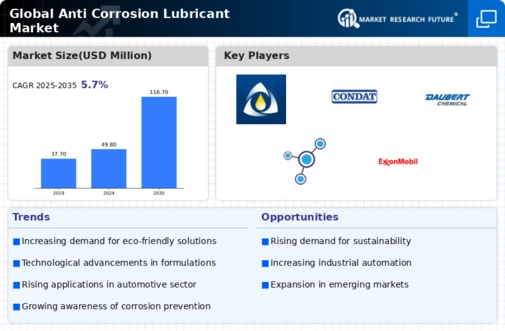Market Analysis
In-depth Analysis of Anti Corrosion Lubricant Market Industry Landscape
The market dynamics of anti-corrosion lubricants are influenced by a range of factors that impact the supply, demand, and overall trends within the industrial and automotive sectors. Anti-corrosion lubricants play a crucial role in preventing corrosion, reducing friction, and ensuring the optimal performance of machinery and moving parts. Understanding the market dynamics involves examining elements such as technological advancements, industry applications, regulatory impacts, environmental considerations, and competitive forces.
Technological advancements are key drivers in the market dynamics of anti-corrosion lubricants. Ongoing innovations in lubricant formulations, additives, and application methods contribute to the development of products that offer superior protection against corrosion while providing effective lubrication. Advanced features such as extended durability, resistance to harsh environments, and compatibility with various materials enhance the overall performance and efficiency of anti-corrosion lubricants. Manufacturers investing in cutting-edge technologies can gain a competitive edge by offering products that meet the evolving needs of industries requiring reliable and long-lasting lubrication solutions.
Industry applications significantly impact the market dynamics of anti-corrosion lubricants. The demand for these lubricants is closely tied to the performance and protection requirements of machinery and equipment in various sectors. In the automotive industry, anti-corrosion lubricants are essential for protecting critical components such as bearings and joints from corrosion and wear. Similarly, in the industrial sector, machinery exposed to harsh conditions or outdoor environments requires effective anti-corrosion lubrication to ensure longevity and optimal performance. Manufacturers must stay attuned to industry applications and customer requirements to align their product offerings with the diverse needs of users.
Regulatory impacts, including safety standards and environmental regulations, influence the market dynamics of anti-corrosion lubricants. Compliance with regulations related to workplace safety, chemical usage, and environmental impact is essential for manufacturers to ensure product acceptance and adherence to legal requirements. As environmental concerns grow, there is an increased focus on lubricants formulated with environmentally friendly additives and packaging. Adapting to evolving regulatory standards and maintaining transparency in product labeling are critical for manufacturers to navigate the complex landscape of lubricant regulations.
Environmental considerations pose both a challenge and an opportunity in the market dynamics of anti-corrosion lubricants. As sustainability becomes a key focus across industries, there is a growing demand for lubrication solutions that minimize environmental impact. Lubricant manufacturers are exploring eco-friendly formulations, biodegradable additives, and sustainable packaging to address these concerns. Offering lubricants that provide effective protection while being environmentally responsible is crucial for manufacturers seeking to capture market share in an increasingly eco-conscious business environment.
Challenges within the market dynamics include price competitiveness, customization demands, and the need for effective marketing. The anti-corrosion lubricant market is characterized by competition among manufacturers, leading to pricing considerations that may impact profit margins. Additionally, industries may have specific requirements based on the type of machinery and conditions they operate in, necessitating customized formulations for effective lubrication and corrosion protection. Manufacturers must invest in effective marketing strategies to educate consumers and businesses about the importance of using high-quality anti-corrosion lubricants and the benefits they offer.
The competitive landscape is a significant aspect influencing the market dynamics of anti-corrosion lubricants. The industry is marked by a diverse range of manufacturers vying for market share, and differentiation is key. Companies strive to distinguish themselves through factors such as lubrication performance, corrosion protection, sustainability features, and brand reputation. Understanding and adapting to changing industry needs, emerging technologies, and customer preferences are essential for success in this competitive market.
Global considerations, including trade dynamics and regional preferences, also impact the market for anti-corrosion lubricants. Manufacturers may need to navigate varying regulations, trade agreements, and industrial practices across different regions. Adapting to market dynamics in different parts of the world is crucial for companies aiming to establish a strong and sustainable presence in the global anti-corrosion lubricant market.









Leave a Comment